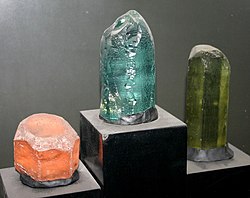Beryl/Aquamarine: Difference between revisions
No edit summary |
Added Template |
||
| Line 67: | Line 67: | ||
{{Jewellery Materials}} |
{{Jewellery Materials}} |
||
{{Gems & Crystals}} |
|||
[[Category:Silicate minerals]] |
[[Category:Silicate minerals]] |
||
[[Category:Gemstones]] |
[[Category:Gemstones]] |
||
Revision as of 06:37, 24 April 2007
| Aquamarine | |
|---|---|
 Aquamarine | |
| General | |
| Category | beryl mineral variety |
| Formula (repeating unit) | Be3Al2Si6O18[1] |
| Crystal system | hexagonal[1] |
| Identification | |
| Color | transparent (or can be translucent if included), greenish blue to blue green, typically light in tone[1] |
| Cleavage | very difficult in one direction, almost never seen[1] |
| Fracture | conchoidal[1] |
| Mohs scale hardness | 7.5 - 8[1] |
| Luster | vitreous to resinous[1] |
| Specific gravity | 2.72 (+.18, -.05)[1] |
| Polish luster | vitreous [1] |
| Optical properties | Double refractive, uniaxial negative[1] |
| Refractive index | 1.577 - 1.583 (+/- .017)[1] |
| Birefringence | .005 - .009[1] |
| Pleochroism | weak to moderate, blue and greenish blue; or different tones of blue with lighter tones associated with the optic axis direction [1] |
| Dispersion | .014[1] |
| Ultraviolet fluorescence | inert[1] |
| Absorption spectra | indistinct lines at 537 and 456nm. Depending on the depth of color, there is a strong line at 427nm.[1] |
Aquamarine (Lat. aqua marinā, "water of the sea") is a gemstone-quality transparent variety of beryl, having a delicate blue or turquoise color, suggestive of the tint of seawater. It's closely related to the gem emerald. Colors vary and yellow beryl, called heliodor; rose pink beryl, morganite; and white beryl, goshenite are known.
Aquamarine is a beryl with a hexagonal crystal structure and a chemical formula of Be3Al2Si6O18, a beryllium aluminium silicate mineral. It has a specific gravity of 2.68 to 2.74 and a Mohs hardness of from 7.5 to 8. Aquamarine typically is on the low end of the specific gravity range, normally at less than 2.7. The pink variety exhibits a high specific gravity of around 2.8. Refractive indices range around 1.57 to 1.58.
It occurs at most localities which yield ordinary beryl, some of the finest coming from Russia. The gem-gravel placer deposits of Sri Lanka contain aquamarine. Clear yellow beryl, such as occurs in Brazil, is sometimes called aquamarine chrysolite. When corundum presents the bluish tint of typical aquamarine, it is often termed Oriental aquamarine.
In the United States, aquamarines can be found at the summit of Mt. Antero in the Sawatch Range in central Colorado. In Brazil, there are mines in the states of Minas Gerais, Espírito Santo and Bahia. Zambia also produces nice aquamarine as well as Madagascar, Malawi, Tanzania and Kenya. Much of today's aquamarine is heated to give it a better color blue. The deeper the blue color, the more valuable the gem is considered.
The biggest aquamarine ever mined was found at the city of Marambaia, Minas Gerais, Brazil, in 1910. It weighed over 110 kg, and its dimensions were 48.5 cm long and 42 cm in diameter.
Aquamarine is the official state gem of Colorado.
Culture and historical/mythical usage
- Aquamarine is the birthstone associated with March. It is also the gemstone for the 19th Anniversary.
- People in the Middle Ages thought that aquamarine could magically overcome the effects of poison.
- Ancient sailors traveled with aquamarine crystals, believing that it would ensure a safe passage, and often slept with the stones under their pillow to ensure sound sleep. They believed the siren’s (mermaid) fish-like lower body was made of aquamarine.
See also

References
- Weinstein, Michael, 1958, The World of Jewel Stones Sheriden House, New York, pp 104-107
- Diamond Bug. "Flawless Aquamarine: March Birthstone". Retrieved March 16, 2006.
- http://www.gemstone.org/gem-by-gem/english/aquamarine.html
- http://mineral.galleries.com/minerals/gemstone/aquamari/aquamari.htm
- http://www.mindat.org/min-289.html
